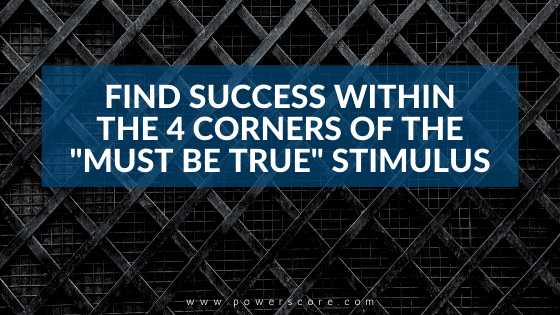Often, people studying for the LSAT have trouble figuring out how the test has anything to do with real life, let alone law school or the practice of law. But the connection is clear with Must Be True questions. It all comes down to the “four corners” rule.
The Four Corners Rule
In Must Be True questions, you’re limited to the information in the stimulus. You can’t bring in any outside information. So, the correct answer choice will be either a restatement of something stated explicitly within the stimulus or an inference that’s possible from a combination of those statements.
Essentially, you’re stuck to what’s within the “four corners” of the stimulus when you consider what must be true. Interestingly, the same concept controls how courts interpret a whole range of documents in the legal world.
The most well known example of this is the “four corners” rule of contractual interpretation. Basically, when a court is asked to decide what a contract means, it first looks to see if it can figure out the meaning based just on the words of the contract itself, i.e., what’s contained within the four corners of the paper the contract is written on. Sometimes it can’t. When the court can’t figure out the intent of the parties from the language within the contract itself, then the court can look to extrinsic evidence, i.e., evidence found outside of the four corners of the contract, to determine their intent.
Federal Court Example
As another example, a “four corners” rule applies to a federal trial court deciding whether to grant a party’s motion to dismiss the other party’s claim pursuant to Federal Rule 12(B)(6). In fact, this quote from a federal opinion could just as easily refer to the way we approach Must Be True questions:
On a motion to dismiss, this Court accepts as true all of the factual allegations in the complaint and construes them in the light most favorable to the plaintiff. Jackson v. Bellsouth Telecomms., 372 F.3d 1250, 1262 (11th Cir. 2004). Further, this Court favors the plaintiff with all reasonable inferences from the allegations in the complaint. Stephens v. Dep’t of Health & Human Servs., 901 F.2d 1571, 1573 (11th Cir. 1990)(“On a motion to dismiss, the facts stated in [the] complaint and all reasonable inferences therefrom are taken as true.”).
Lacy v. City of St. Petersburg (M.D. Fla., 2014)
How about another example? When a federal court reviews whether a magistrate made the right decision in authorizing a search warrant, it looks to see if the information contained within the four corners of the affidavit offered in support of the search warrant rises to the level of probable cause.
The list goes on and on. In each instance, the general rule is that the court stays within the four corners of whatever document it reviews. The purpose behind this pattern of rules is to provide some certainty, stability, and finality to our actions and decisions. And, just like in life, we crave certainty on the LSAT as well.
Staying Within the Four Corners in Must Be True Questions
People often make the LSAT more difficult than it needs to be, both generally and specifically in reference to Must Be True questions, by going outside of the “four corners.” When you open up your interpretation of a Must Be True stimulus to facts outside of the stimulus itself, you multiply the difficulty of your task. Keep things simple by staying within the stimulus. Don’t cloud your mind with all of the could be trues and what-ifs that take you down the rabbit hole of attractive incorrect answer choices.
If you find that you do this very thing I’m telling you to avoid, consider why you do it. Some folks bring in all of the common sense could-be-trues that get them in trouble because they aren’t comfortable with how to attack the stimulus the right way. For example, if a Must Be True stimulus has multiple conditional relationships in it and the person is uncomfortable with those relationships, he may ignore the conditionality and think of things that make real world sense based on the other context of the stimulus. The person may have avoided the conditionality, but by doing so has veered off course, out of the four corners of the stimulus and into the no-man’s-land of attractive distractor answer choices.
So, when dealing with Must Be True questions, be sure to stay within the four corners of the stimulus. If you understand this rule but consistently find yourself violating it, ask yourself what it is that you’re avoiding. Stop making your task harder than it is. Embrace the narrow certainty of the Must Be True stimulus.


Leave a Reply